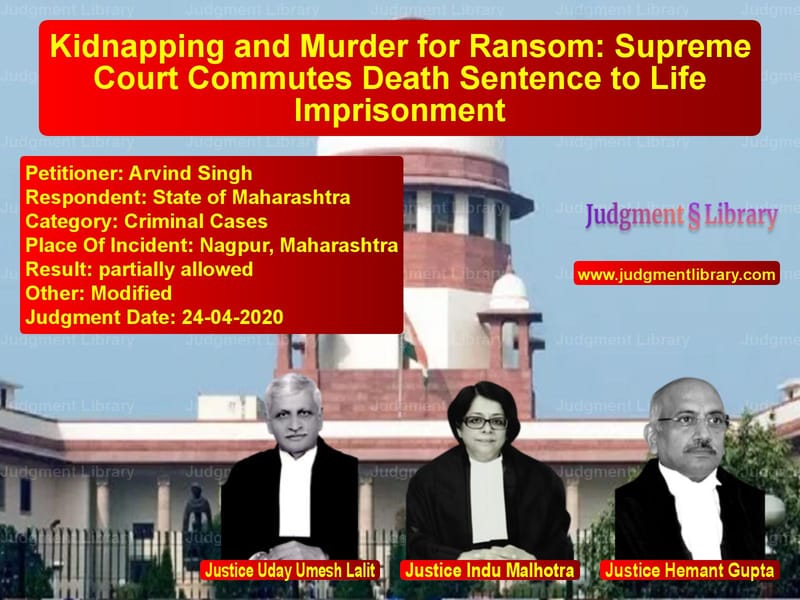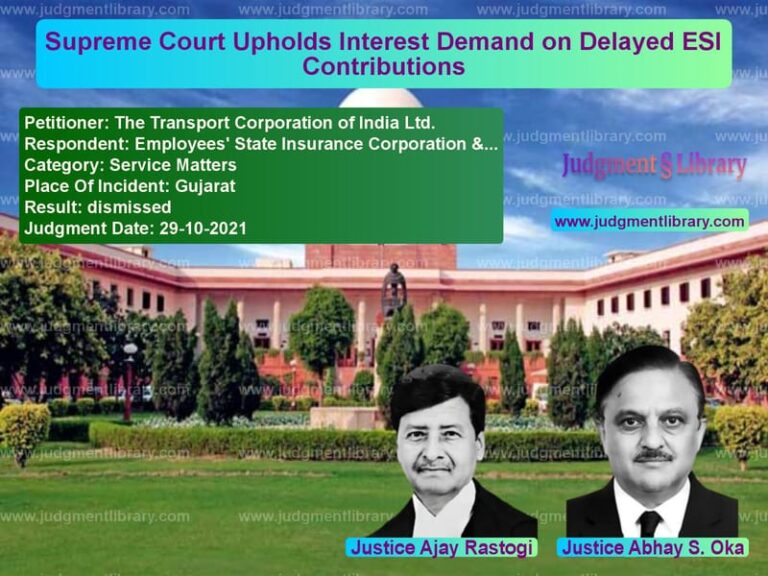Kidnapping and Murder for Ransom: Supreme Court Commutes Death Sentence to Life Imprisonment
The case of Arvind Singh vs. The State of Maharashtra revolved around a shocking crime involving the kidnapping and murder of an 8-year-old child, Yug, for ransom. The Supreme Court of India, after thoroughly analyzing the evidence, upheld the conviction of the accused but commuted the death sentence to life imprisonment with a condition that they must serve at least 25 years before being eligible for remission.
Background of the Case
On September 1, 2014, Dr. Mukesh Ramanlal Chandak, a well-known dentist in Nagpur, Maharashtra, lodged a missing complaint for his son Yug. Investigations revealed that the boy was lured away from his home by two individuals dressed in clinic staff uniforms, later identified as Arvind Singh and Rajesh Daware. The accused had planned to demand ransom from the family.
Hours after the abduction, Dr. Chandak received ransom calls demanding Rs. 10 crores, later reduced to Rs. 5 crores. However, before any ransom could be paid, the child was found dead in a nullah, buried under debris with severe injuries, indicating smothering and physical assault.
Legal Charges and Convictions
The accused were charged under multiple sections of the Indian Penal Code (IPC), including:
- Section 364A IPC: Kidnapping for ransom with threat to cause death.
- Section 302 IPC: Murder.
- Section 120B IPC: Criminal conspiracy.
- Section 201 IPC: Causing disappearance of evidence.
The Sessions Court sentenced both accused to death, which was later confirmed by the High Court of Bombay. The case reached the Supreme Court on appeal.
Petitioner’s Arguments (Arvind Singh & Co-Accused)
- The defense argued that the prosecution failed to establish direct evidence linking them to the murder.
- They claimed that the kidnapping was solely for ransom and that the murder was not premeditated.
- They pointed out discrepancies in the witness testimonies, especially in the identification parade.
- The defense contended that since they had no criminal antecedents and were young, the death penalty was excessive.
Respondent’s Arguments (State of Maharashtra)
- The prosecution presented overwhelming circumstantial evidence, including CCTV footage, call records, and last-seen testimonies.
- The accused’s confession led to the recovery of the child’s body, corroborating their involvement.
- The demand for ransom and the brutal killing of a young child made this one of the “rarest of rare” cases deserving capital punishment.
- The state argued that the crime was executed in a planned manner, warranting the highest punishment.
Supreme Court’s Observations
The Supreme Court analyzed various aspects of the case:
- Kidnapping for Ransom: The Court held that kidnapping for ransom inherently involves a threat to the victim’s life.
- Last-Seen Theory: Multiple witnesses confirmed that the accused were last seen with the child before his death.
- Failure to Provide Explanation: The accused did not provide a reasonable explanation for the victim’s fate, shifting the burden onto them under Section 106 of the Indian Evidence Act.
- Injuries on the Victim: Forensic reports indicated that the victim had been smothered, confirming homicide.
The Court remarked, “The burden of proving the accused’s innocence shifts when they fail to explain what happened to the victim last seen with them.”
Final Judgment
After reviewing the case, the Supreme Court made the following rulings:
- The conviction under Sections 364A and 302 IPC was upheld.
- The death sentence was commuted to life imprisonment.
- The accused must serve a minimum of 25 years before being eligible for remission.
- The Court took into account their young age and lack of prior criminal records but emphasized the severity of the crime.
Implications of the Judgment
This ruling sets a precedent in cases involving kidnapping and murder for ransom:
- It reiterates that life imprisonment with strict conditions can be an alternative to the death penalty.
- It upholds the importance of circumstantial evidence in securing convictions.
- It stresses the accountability of those who fail to explain the disappearance of victims last seen with them.
The Supreme Court’s decision serves as a strong deterrent against crimes involving ransom and child murder, while also ensuring that young offenders are not completely denied the possibility of reform.
Petitioner Name: Arvind Singh.Respondent Name: State of Maharashtra.Judgment By: Justice Uday Umesh Lalit, Justice Indu Malhotra, Justice Hemant Gupta.Place Of Incident: Nagpur, Maharashtra.Judgment Date: 24-04-2020.
Don’t miss out on the full details! Download the complete judgment in PDF format below and gain valuable insights instantly!
Download Judgment: Arvind Singh vs State of Maharashtra Supreme Court of India Judgment Dated 24-04-2020.pdf
Direct Downlaod Judgment: Direct downlaod this Judgment
See all petitions in Murder Cases
See all petitions in Bail and Anticipatory Bail
See all petitions in Juvenile Justice
See all petitions in Judgment by Uday Umesh Lalit
See all petitions in Judgment by Indu Malhotra
See all petitions in Judgment by Hemant Gupta
See all petitions in partially allowed
See all petitions in Modified
See all petitions in supreme court of India judgments April 2020
See all petitions in 2020 judgments
See all posts in Criminal Cases Category
See all allowed petitions in Criminal Cases Category
See all Dismissed petitions in Criminal Cases Category
See all partially allowed petitions in Criminal Cases Category







